The long hours spent on smartphones
VerifiedAdded on 2022/09/14
|14
|3154
|13
AI Summary
Contribute Materials
Your contribution can guide someone’s learning journey. Share your
documents today.
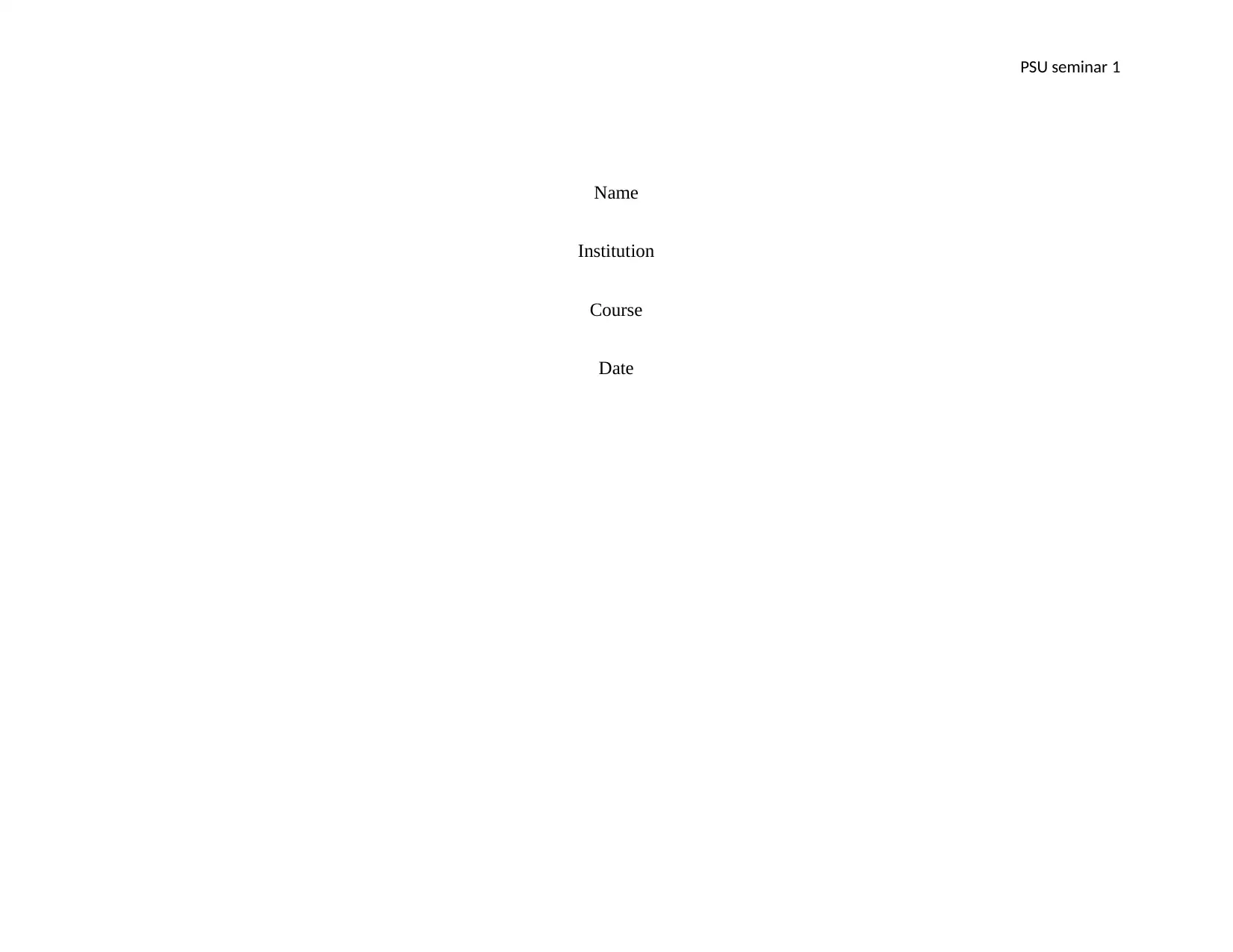
PSU seminar 1
Name
Institution
Course
Date
Name
Institution
Course
Date
Secure Best Marks with AI Grader
Need help grading? Try our AI Grader for instant feedback on your assignments.
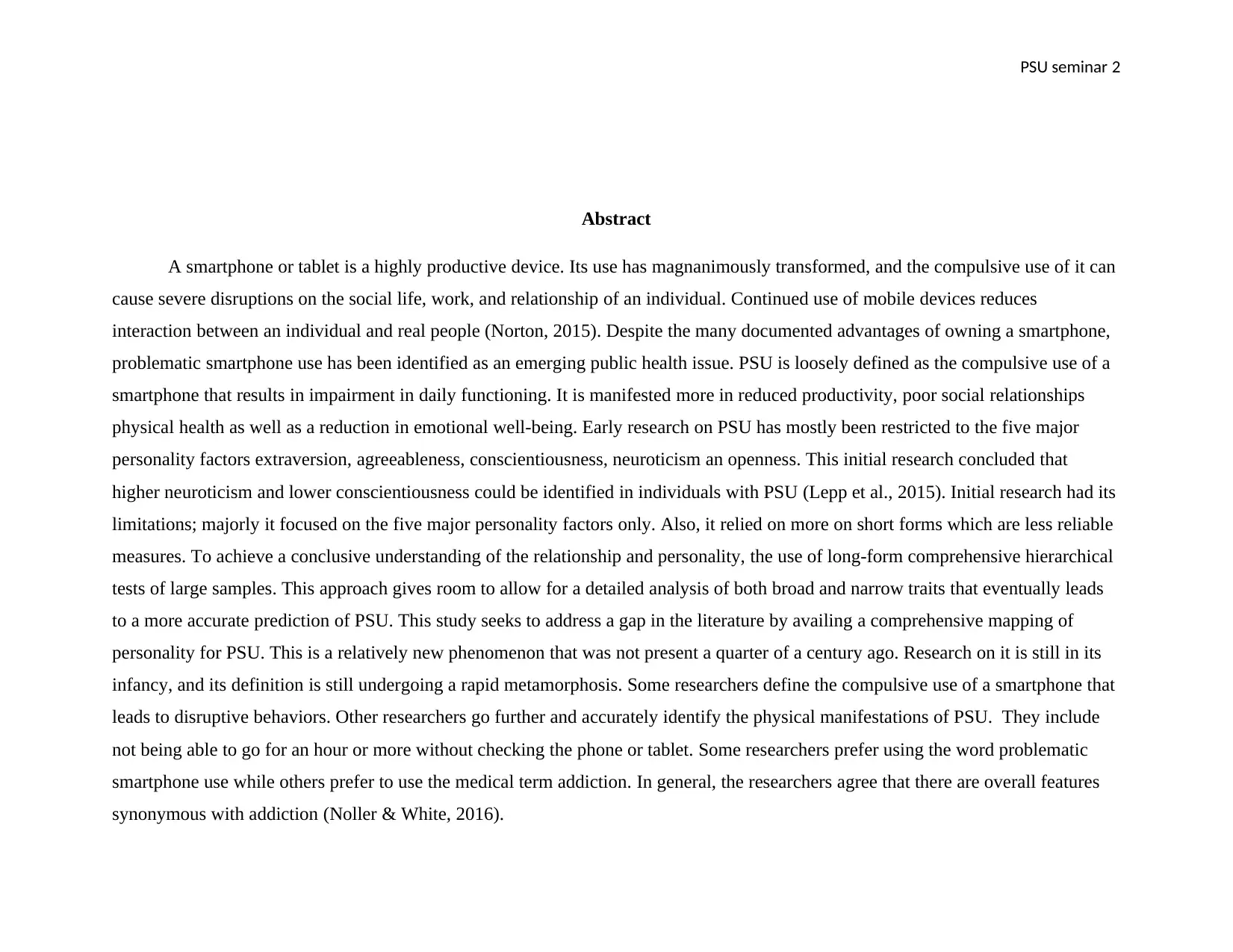
PSU seminar 2
Abstract
A smartphone or tablet is a highly productive device. Its use has magnanimously transformed, and the compulsive use of it can
cause severe disruptions on the social life, work, and relationship of an individual. Continued use of mobile devices reduces
interaction between an individual and real people (Norton, 2015). Despite the many documented advantages of owning a smartphone,
problematic smartphone use has been identified as an emerging public health issue. PSU is loosely defined as the compulsive use of a
smartphone that results in impairment in daily functioning. It is manifested more in reduced productivity, poor social relationships
physical health as well as a reduction in emotional well-being. Early research on PSU has mostly been restricted to the five major
personality factors extraversion, agreeableness, conscientiousness, neuroticism an openness. This initial research concluded that
higher neuroticism and lower conscientiousness could be identified in individuals with PSU (Lepp et al., 2015). Initial research had its
limitations; majorly it focused on the five major personality factors only. Also, it relied on more on short forms which are less reliable
measures. To achieve a conclusive understanding of the relationship and personality, the use of long-form comprehensive hierarchical
tests of large samples. This approach gives room to allow for a detailed analysis of both broad and narrow traits that eventually leads
to a more accurate prediction of PSU. This study seeks to address a gap in the literature by availing a comprehensive mapping of
personality for PSU. This is a relatively new phenomenon that was not present a quarter of a century ago. Research on it is still in its
infancy, and its definition is still undergoing a rapid metamorphosis. Some researchers define the compulsive use of a smartphone that
leads to disruptive behaviors. Other researchers go further and accurately identify the physical manifestations of PSU. They include
not being able to go for an hour or more without checking the phone or tablet. Some researchers prefer using the word problematic
smartphone use while others prefer to use the medical term addiction. In general, the researchers agree that there are overall features
synonymous with addiction (Noller & White, 2016).
Abstract
A smartphone or tablet is a highly productive device. Its use has magnanimously transformed, and the compulsive use of it can
cause severe disruptions on the social life, work, and relationship of an individual. Continued use of mobile devices reduces
interaction between an individual and real people (Norton, 2015). Despite the many documented advantages of owning a smartphone,
problematic smartphone use has been identified as an emerging public health issue. PSU is loosely defined as the compulsive use of a
smartphone that results in impairment in daily functioning. It is manifested more in reduced productivity, poor social relationships
physical health as well as a reduction in emotional well-being. Early research on PSU has mostly been restricted to the five major
personality factors extraversion, agreeableness, conscientiousness, neuroticism an openness. This initial research concluded that
higher neuroticism and lower conscientiousness could be identified in individuals with PSU (Lepp et al., 2015). Initial research had its
limitations; majorly it focused on the five major personality factors only. Also, it relied on more on short forms which are less reliable
measures. To achieve a conclusive understanding of the relationship and personality, the use of long-form comprehensive hierarchical
tests of large samples. This approach gives room to allow for a detailed analysis of both broad and narrow traits that eventually leads
to a more accurate prediction of PSU. This study seeks to address a gap in the literature by availing a comprehensive mapping of
personality for PSU. This is a relatively new phenomenon that was not present a quarter of a century ago. Research on it is still in its
infancy, and its definition is still undergoing a rapid metamorphosis. Some researchers define the compulsive use of a smartphone that
leads to disruptive behaviors. Other researchers go further and accurately identify the physical manifestations of PSU. They include
not being able to go for an hour or more without checking the phone or tablet. Some researchers prefer using the word problematic
smartphone use while others prefer to use the medical term addiction. In general, the researchers agree that there are overall features
synonymous with addiction (Noller & White, 2016).
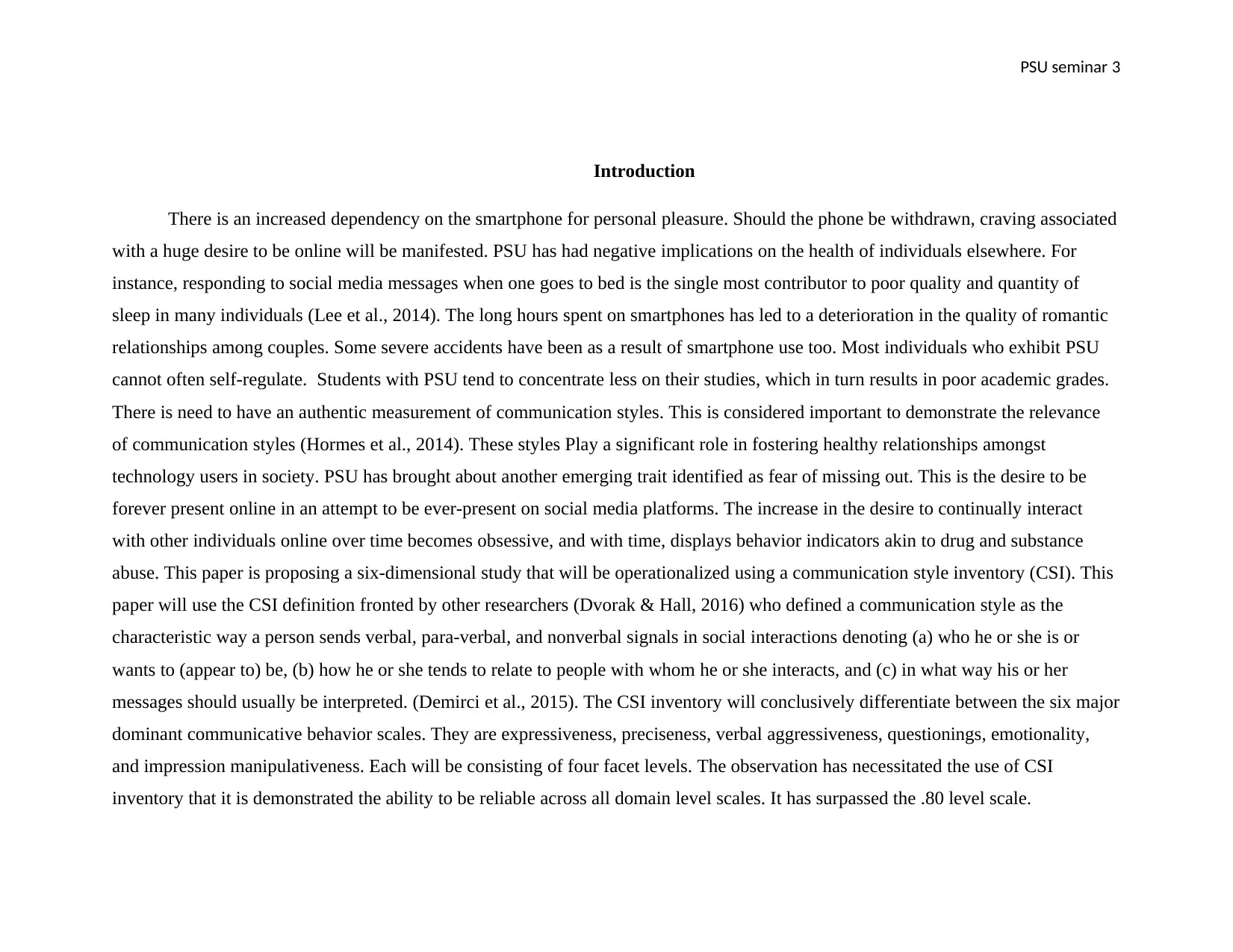
PSU seminar 3
Introduction
There is an increased dependency on the smartphone for personal pleasure. Should the phone be withdrawn, craving associated
with a huge desire to be online will be manifested. PSU has had negative implications on the health of individuals elsewhere. For
instance, responding to social media messages when one goes to bed is the single most contributor to poor quality and quantity of
sleep in many individuals (Lee et al., 2014). The long hours spent on smartphones has led to a deterioration in the quality of romantic
relationships among couples. Some severe accidents have been as a result of smartphone use too. Most individuals who exhibit PSU
cannot often self-regulate. Students with PSU tend to concentrate less on their studies, which in turn results in poor academic grades.
There is need to have an authentic measurement of communication styles. This is considered important to demonstrate the relevance
of communication styles (Hormes et al., 2014). These styles Play a significant role in fostering healthy relationships amongst
technology users in society. PSU has brought about another emerging trait identified as fear of missing out. This is the desire to be
forever present online in an attempt to be ever-present on social media platforms. The increase in the desire to continually interact
with other individuals online over time becomes obsessive, and with time, displays behavior indicators akin to drug and substance
abuse. This paper is proposing a six-dimensional study that will be operationalized using a communication style inventory (CSI). This
paper will use the CSI definition fronted by other researchers (Dvorak & Hall, 2016) who defined a communication style as the
characteristic way a person sends verbal, para-verbal, and nonverbal signals in social interactions denoting (a) who he or she is or
wants to (appear to) be, (b) how he or she tends to relate to people with whom he or she interacts, and (c) in what way his or her
messages should usually be interpreted. (Demirci et al., 2015). The CSI inventory will conclusively differentiate between the six major
dominant communicative behavior scales. They are expressiveness, preciseness, verbal aggressiveness, questionings, emotionality,
and impression manipulativeness. Each will be consisting of four facet levels. The observation has necessitated the use of CSI
inventory that it is demonstrated the ability to be reliable across all domain level scales. It has surpassed the .80 level scale.
Introduction
There is an increased dependency on the smartphone for personal pleasure. Should the phone be withdrawn, craving associated
with a huge desire to be online will be manifested. PSU has had negative implications on the health of individuals elsewhere. For
instance, responding to social media messages when one goes to bed is the single most contributor to poor quality and quantity of
sleep in many individuals (Lee et al., 2014). The long hours spent on smartphones has led to a deterioration in the quality of romantic
relationships among couples. Some severe accidents have been as a result of smartphone use too. Most individuals who exhibit PSU
cannot often self-regulate. Students with PSU tend to concentrate less on their studies, which in turn results in poor academic grades.
There is need to have an authentic measurement of communication styles. This is considered important to demonstrate the relevance
of communication styles (Hormes et al., 2014). These styles Play a significant role in fostering healthy relationships amongst
technology users in society. PSU has brought about another emerging trait identified as fear of missing out. This is the desire to be
forever present online in an attempt to be ever-present on social media platforms. The increase in the desire to continually interact
with other individuals online over time becomes obsessive, and with time, displays behavior indicators akin to drug and substance
abuse. This paper is proposing a six-dimensional study that will be operationalized using a communication style inventory (CSI). This
paper will use the CSI definition fronted by other researchers (Dvorak & Hall, 2016) who defined a communication style as the
characteristic way a person sends verbal, para-verbal, and nonverbal signals in social interactions denoting (a) who he or she is or
wants to (appear to) be, (b) how he or she tends to relate to people with whom he or she interacts, and (c) in what way his or her
messages should usually be interpreted. (Demirci et al., 2015). The CSI inventory will conclusively differentiate between the six major
dominant communicative behavior scales. They are expressiveness, preciseness, verbal aggressiveness, questionings, emotionality,
and impression manipulativeness. Each will be consisting of four facet levels. The observation has necessitated the use of CSI
inventory that it is demonstrated the ability to be reliable across all domain level scales. It has surpassed the .80 level scale.
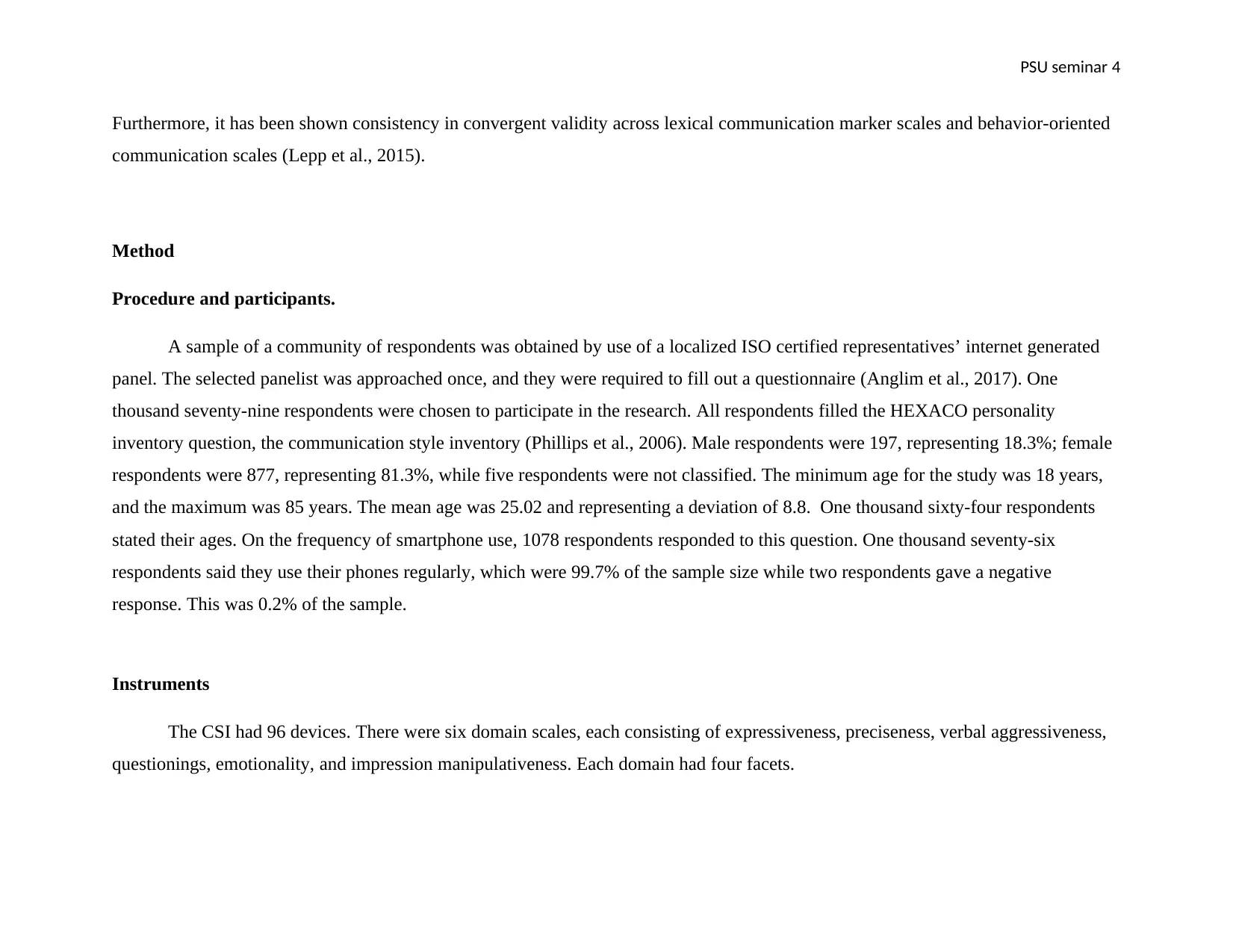
PSU seminar 4
Furthermore, it has been shown consistency in convergent validity across lexical communication marker scales and behavior-oriented
communication scales (Lepp et al., 2015).
Method
Procedure and participants.
A sample of a community of respondents was obtained by use of a localized ISO certified representatives’ internet generated
panel. The selected panelist was approached once, and they were required to fill out a questionnaire (Anglim et al., 2017). One
thousand seventy-nine respondents were chosen to participate in the research. All respondents filled the HEXACO personality
inventory question, the communication style inventory (Phillips et al., 2006). Male respondents were 197, representing 18.3%; female
respondents were 877, representing 81.3%, while five respondents were not classified. The minimum age for the study was 18 years,
and the maximum was 85 years. The mean age was 25.02 and representing a deviation of 8.8. One thousand sixty-four respondents
stated their ages. On the frequency of smartphone use, 1078 respondents responded to this question. One thousand seventy-six
respondents said they use their phones regularly, which were 99.7% of the sample size while two respondents gave a negative
response. This was 0.2% of the sample.
Instruments
The CSI had 96 devices. There were six domain scales, each consisting of expressiveness, preciseness, verbal aggressiveness,
questionings, emotionality, and impression manipulativeness. Each domain had four facets.
Furthermore, it has been shown consistency in convergent validity across lexical communication marker scales and behavior-oriented
communication scales (Lepp et al., 2015).
Method
Procedure and participants.
A sample of a community of respondents was obtained by use of a localized ISO certified representatives’ internet generated
panel. The selected panelist was approached once, and they were required to fill out a questionnaire (Anglim et al., 2017). One
thousand seventy-nine respondents were chosen to participate in the research. All respondents filled the HEXACO personality
inventory question, the communication style inventory (Phillips et al., 2006). Male respondents were 197, representing 18.3%; female
respondents were 877, representing 81.3%, while five respondents were not classified. The minimum age for the study was 18 years,
and the maximum was 85 years. The mean age was 25.02 and representing a deviation of 8.8. One thousand sixty-four respondents
stated their ages. On the frequency of smartphone use, 1078 respondents responded to this question. One thousand seventy-six
respondents said they use their phones regularly, which were 99.7% of the sample size while two respondents gave a negative
response. This was 0.2% of the sample.
Instruments
The CSI had 96 devices. There were six domain scales, each consisting of expressiveness, preciseness, verbal aggressiveness,
questionings, emotionality, and impression manipulativeness. Each domain had four facets.
Secure Best Marks with AI Grader
Need help grading? Try our AI Grader for instant feedback on your assignments.
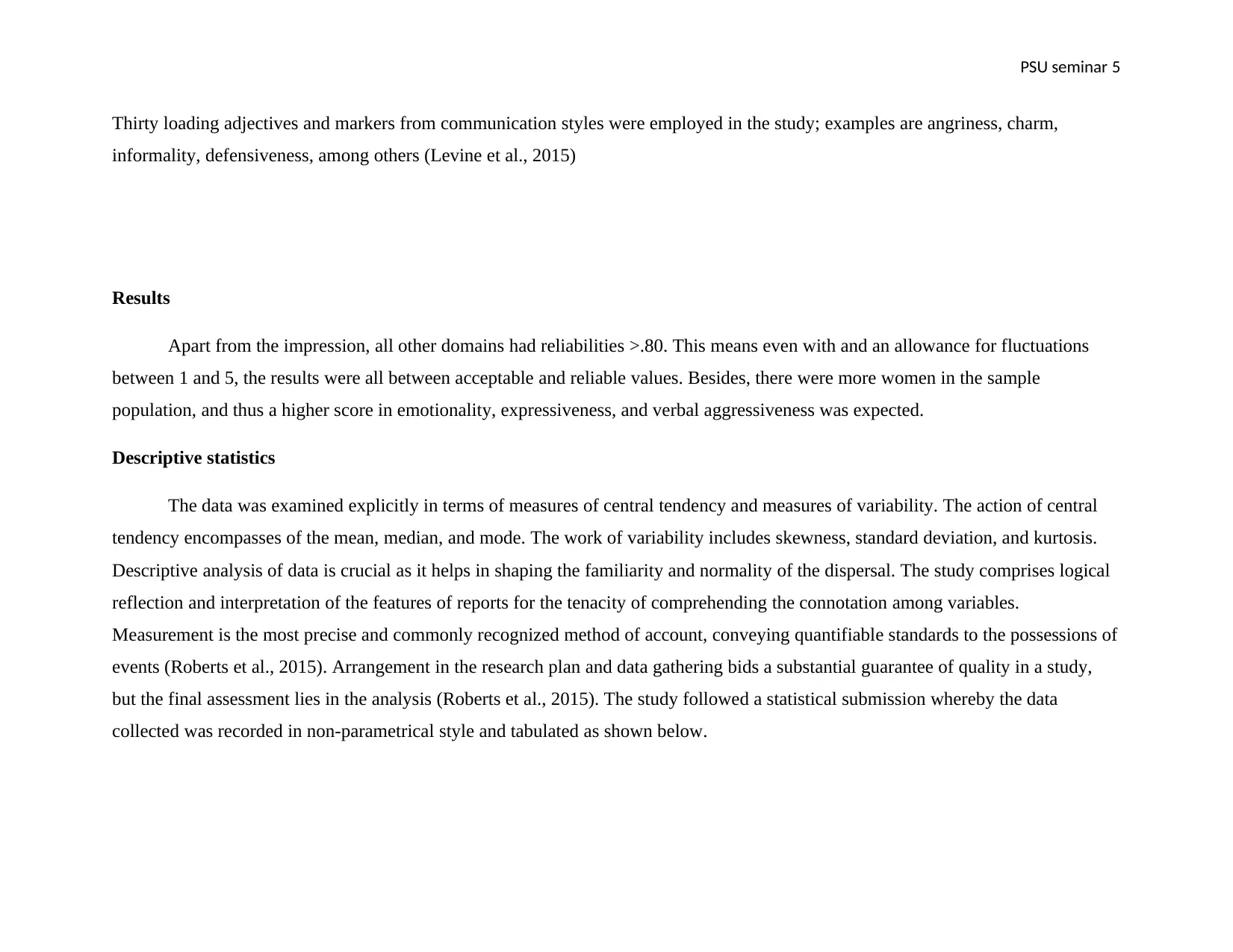
PSU seminar 5
Thirty loading adjectives and markers from communication styles were employed in the study; examples are angriness, charm,
informality, defensiveness, among others (Levine et al., 2015)
Results
Apart from the impression, all other domains had reliabilities >.80. This means even with and an allowance for fluctuations
between 1 and 5, the results were all between acceptable and reliable values. Besides, there were more women in the sample
population, and thus a higher score in emotionality, expressiveness, and verbal aggressiveness was expected.
Descriptive statistics
The data was examined explicitly in terms of measures of central tendency and measures of variability. The action of central
tendency encompasses of the mean, median, and mode. The work of variability includes skewness, standard deviation, and kurtosis.
Descriptive analysis of data is crucial as it helps in shaping the familiarity and normality of the dispersal. The study comprises logical
reflection and interpretation of the features of reports for the tenacity of comprehending the connotation among variables.
Measurement is the most precise and commonly recognized method of account, conveying quantifiable standards to the possessions of
events (Roberts et al., 2015). Arrangement in the research plan and data gathering bids a substantial guarantee of quality in a study,
but the final assessment lies in the analysis (Roberts et al., 2015). The study followed a statistical submission whereby the data
collected was recorded in non-parametrical style and tabulated as shown below.
Thirty loading adjectives and markers from communication styles were employed in the study; examples are angriness, charm,
informality, defensiveness, among others (Levine et al., 2015)
Results
Apart from the impression, all other domains had reliabilities >.80. This means even with and an allowance for fluctuations
between 1 and 5, the results were all between acceptable and reliable values. Besides, there were more women in the sample
population, and thus a higher score in emotionality, expressiveness, and verbal aggressiveness was expected.
Descriptive statistics
The data was examined explicitly in terms of measures of central tendency and measures of variability. The action of central
tendency encompasses of the mean, median, and mode. The work of variability includes skewness, standard deviation, and kurtosis.
Descriptive analysis of data is crucial as it helps in shaping the familiarity and normality of the dispersal. The study comprises logical
reflection and interpretation of the features of reports for the tenacity of comprehending the connotation among variables.
Measurement is the most precise and commonly recognized method of account, conveying quantifiable standards to the possessions of
events (Roberts et al., 2015). Arrangement in the research plan and data gathering bids a substantial guarantee of quality in a study,
but the final assessment lies in the analysis (Roberts et al., 2015). The study followed a statistical submission whereby the data
collected was recorded in non-parametrical style and tabulated as shown below.
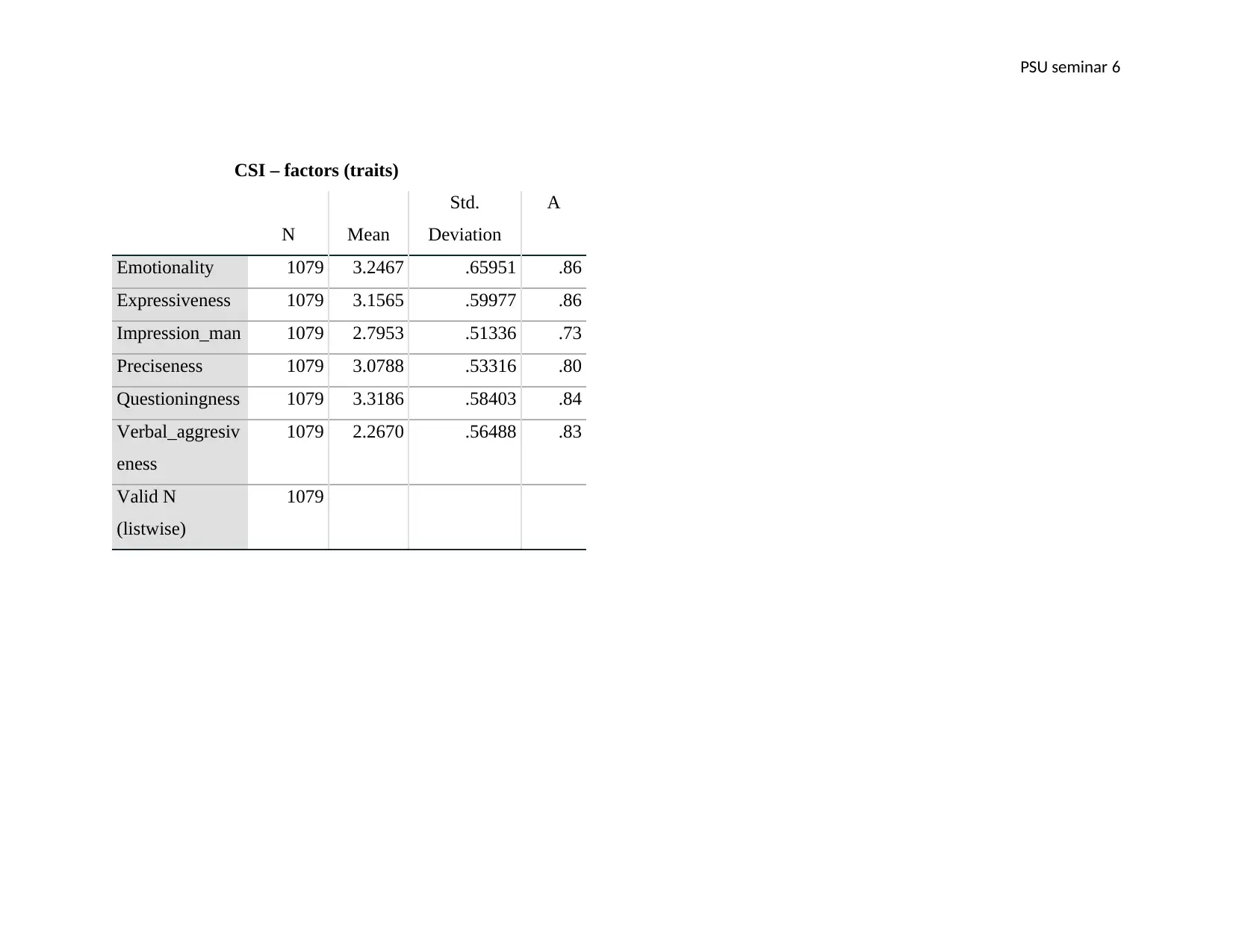
PSU seminar 6
CSI – factors (traits)
N Mean
Std.
Deviation
Α
Emotionality 1079 3.2467 .65951 .86
Expressiveness 1079 3.1565 .59977 .86
Impression_man 1079 2.7953 .51336 .73
Preciseness 1079 3.0788 .53316 .80
Questioningness 1079 3.3186 .58403 .84
Verbal_aggresiv
eness
1079 2.2670 .56488 .83
Valid N
(listwise)
1079
CSI – factors (traits)
N Mean
Std.
Deviation
Α
Emotionality 1079 3.2467 .65951 .86
Expressiveness 1079 3.1565 .59977 .86
Impression_man 1079 2.7953 .51336 .73
Preciseness 1079 3.0788 .53316 .80
Questioningness 1079 3.3186 .58403 .84
Verbal_aggresiv
eness
1079 2.2670 .56488 .83
Valid N
(listwise)
1079
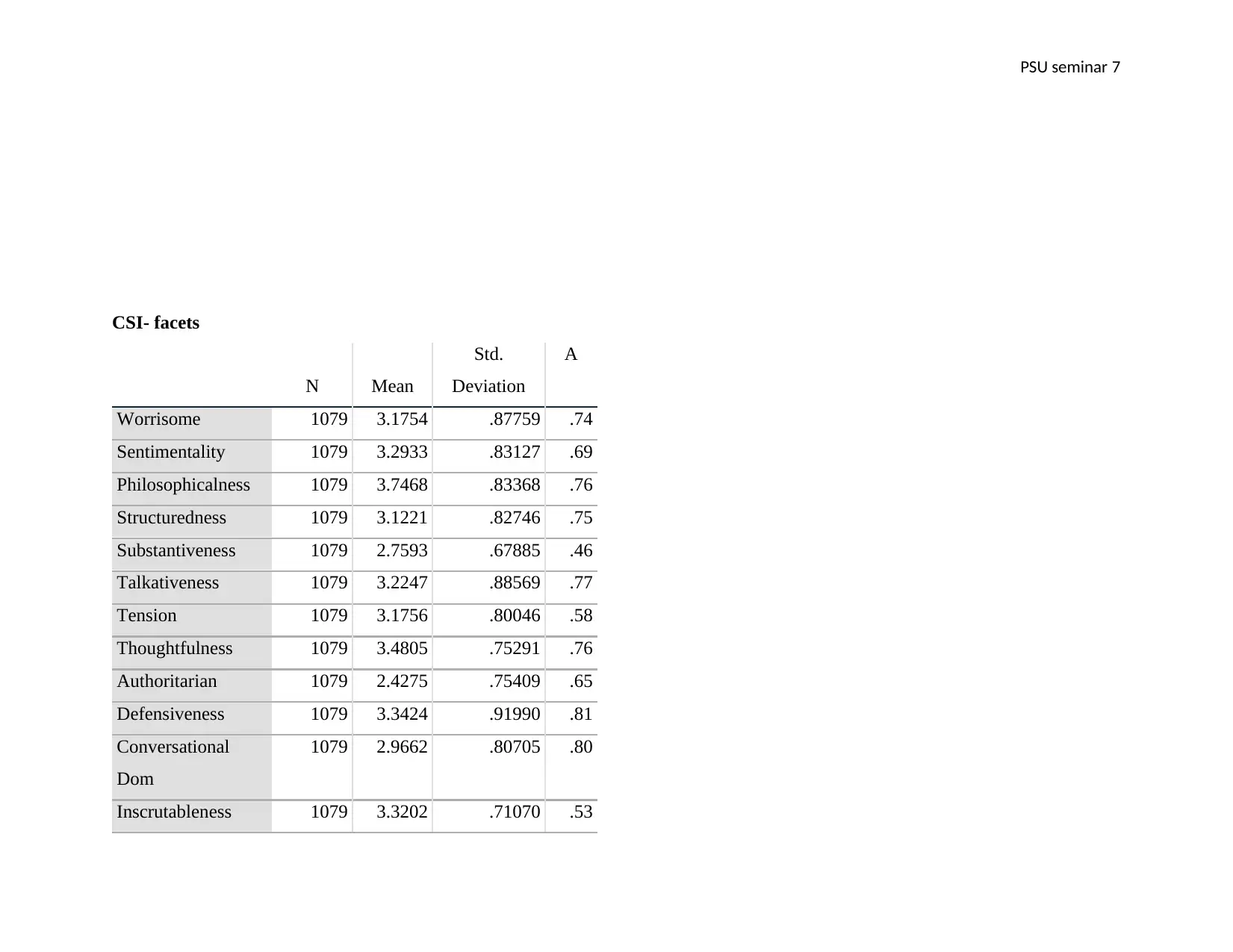
PSU seminar 7
CSI- facets
N Mean
Std.
Deviation
Α
Worrisome 1079 3.1754 .87759 .74
Sentimentality 1079 3.2933 .83127 .69
Philosophicalness 1079 3.7468 .83368 .76
Structuredness 1079 3.1221 .82746 .75
Substantiveness 1079 2.7593 .67885 .46
Talkativeness 1079 3.2247 .88569 .77
Tension 1079 3.1756 .80046 .58
Thoughtfulness 1079 3.4805 .75291 .76
Authoritarian 1079 2.4275 .75409 .65
Defensiveness 1079 3.3424 .91990 .81
Conversational
Dom
1079 2.9662 .80705 .80
Inscrutableness 1079 3.3202 .71070 .53
CSI- facets
N Mean
Std.
Deviation
Α
Worrisome 1079 3.1754 .87759 .74
Sentimentality 1079 3.2933 .83127 .69
Philosophicalness 1079 3.7468 .83368 .76
Structuredness 1079 3.1221 .82746 .75
Substantiveness 1079 2.7593 .67885 .46
Talkativeness 1079 3.2247 .88569 .77
Tension 1079 3.1756 .80046 .58
Thoughtfulness 1079 3.4805 .75291 .76
Authoritarian 1079 2.4275 .75409 .65
Defensiveness 1079 3.3424 .91990 .81
Conversational
Dom
1079 2.9662 .80705 .80
Inscrutableness 1079 3.3202 .71070 .53
Paraphrase This Document
Need a fresh take? Get an instant paraphrase of this document with our AI Paraphraser
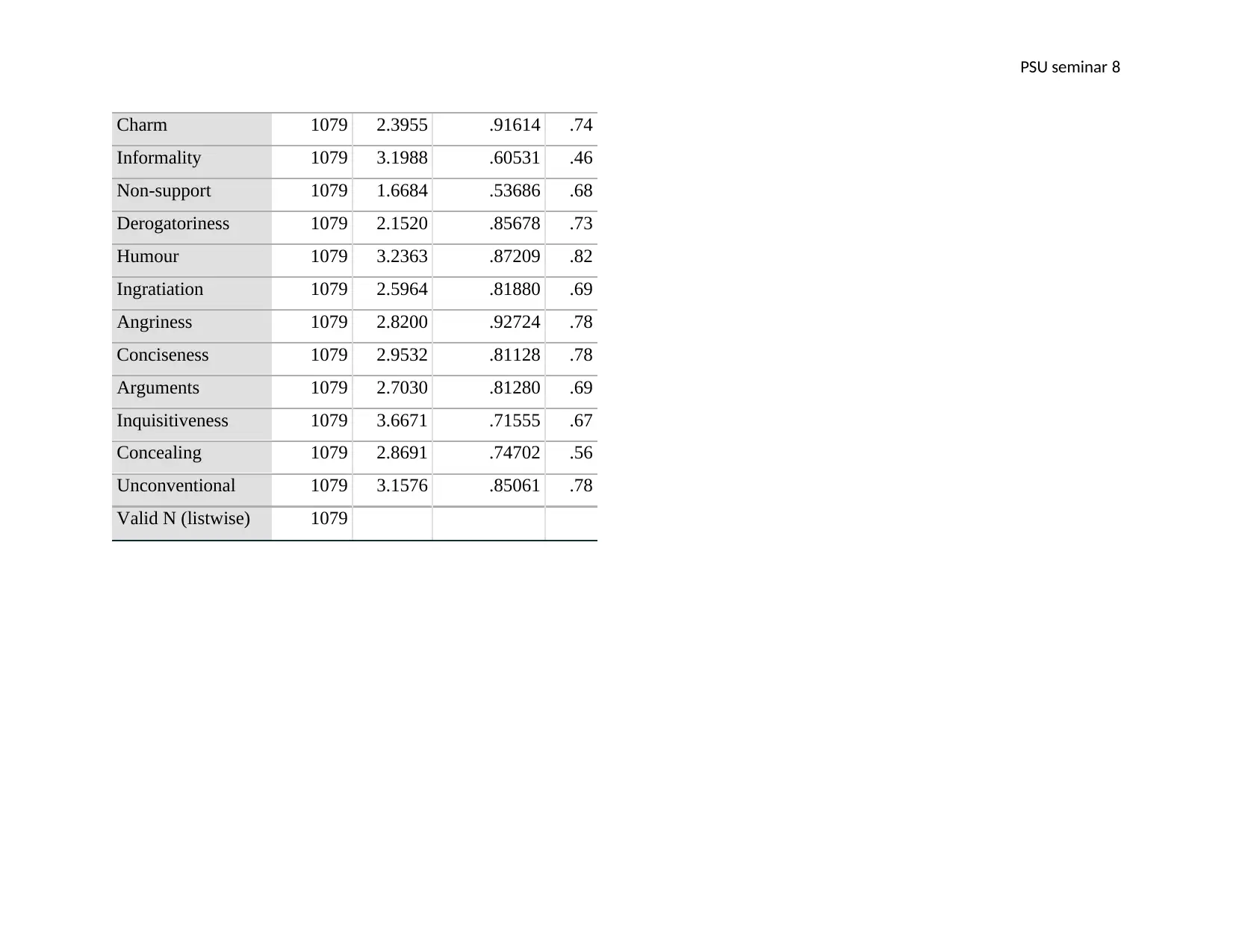
PSU seminar 8
Charm 1079 2.3955 .91614 .74
Informality 1079 3.1988 .60531 .46
Non-support 1079 1.6684 .53686 .68
Derogatoriness 1079 2.1520 .85678 .73
Humour 1079 3.2363 .87209 .82
Ingratiation 1079 2.5964 .81880 .69
Angriness 1079 2.8200 .92724 .78
Conciseness 1079 2.9532 .81128 .78
Arguments 1079 2.7030 .81280 .69
Inquisitiveness 1079 3.6671 .71555 .67
Concealing 1079 2.8691 .74702 .56
Unconventional 1079 3.1576 .85061 .78
Valid N (listwise) 1079
Charm 1079 2.3955 .91614 .74
Informality 1079 3.1988 .60531 .46
Non-support 1079 1.6684 .53686 .68
Derogatoriness 1079 2.1520 .85678 .73
Humour 1079 3.2363 .87209 .82
Ingratiation 1079 2.5964 .81880 .69
Angriness 1079 2.8200 .92724 .78
Conciseness 1079 2.9532 .81128 .78
Arguments 1079 2.7030 .81280 .69
Inquisitiveness 1079 3.6671 .71555 .67
Concealing 1079 2.8691 .74702 .56
Unconventional 1079 3.1576 .85061 .78
Valid N (listwise) 1079
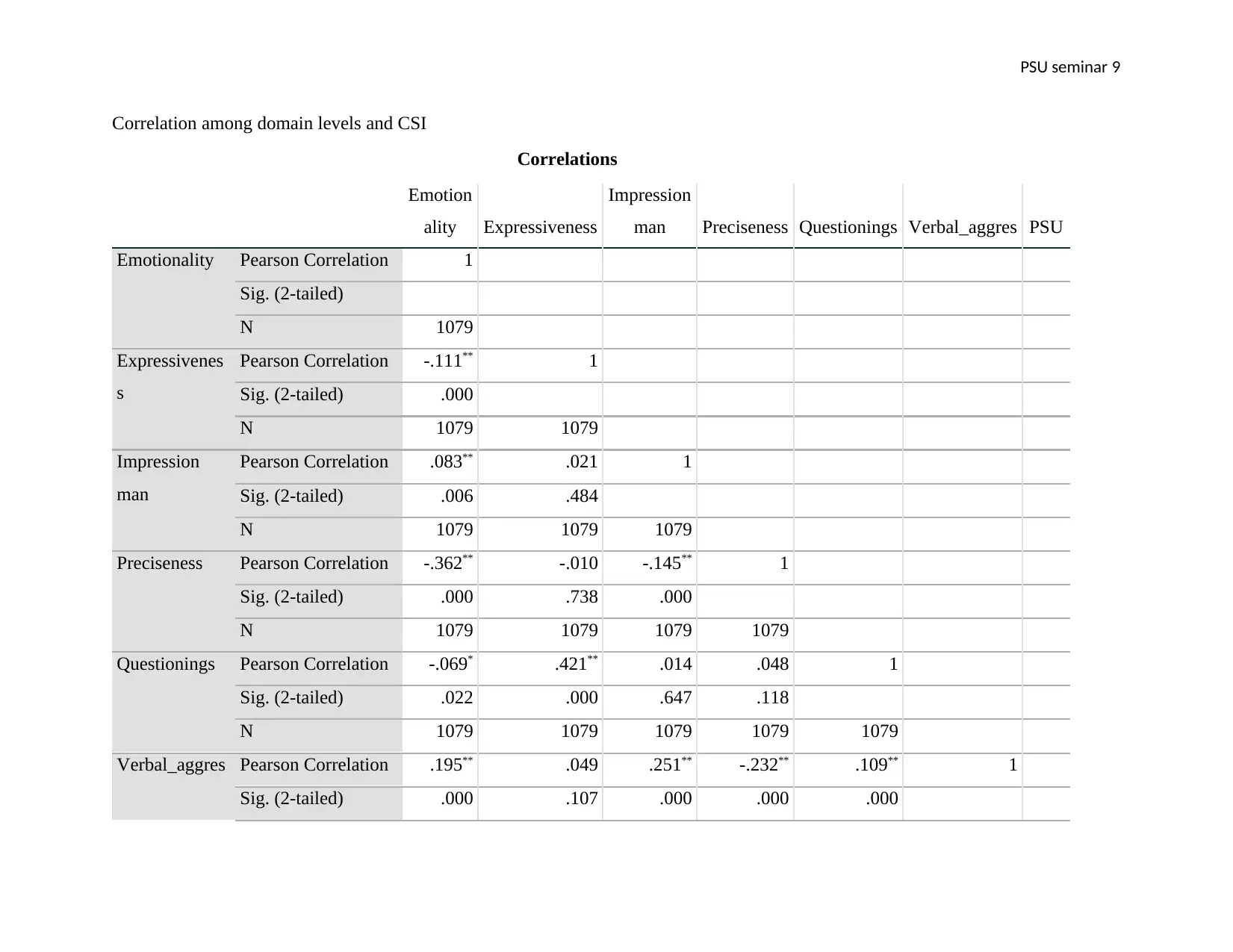
PSU seminar 9
Correlation among domain levels and CSI
Correlations
Emotion
ality Expressiveness
Impression
man Preciseness Questionings Verbal_aggres PSU
Emotionality Pearson Correlation 1
Sig. (2-tailed)
N 1079
Expressivenes
s
Pearson Correlation -.111** 1
Sig. (2-tailed) .000
N 1079 1079
Impression
man
Pearson Correlation .083** .021 1
Sig. (2-tailed) .006 .484
N 1079 1079 1079
Preciseness Pearson Correlation -.362** -.010 -.145** 1
Sig. (2-tailed) .000 .738 .000
N 1079 1079 1079 1079
Questionings Pearson Correlation -.069* .421** .014 .048 1
Sig. (2-tailed) .022 .000 .647 .118
N 1079 1079 1079 1079 1079
Verbal_aggres Pearson Correlation .195** .049 .251** -.232** .109** 1
Sig. (2-tailed) .000 .107 .000 .000 .000
Correlation among domain levels and CSI
Correlations
Emotion
ality Expressiveness
Impression
man Preciseness Questionings Verbal_aggres PSU
Emotionality Pearson Correlation 1
Sig. (2-tailed)
N 1079
Expressivenes
s
Pearson Correlation -.111** 1
Sig. (2-tailed) .000
N 1079 1079
Impression
man
Pearson Correlation .083** .021 1
Sig. (2-tailed) .006 .484
N 1079 1079 1079
Preciseness Pearson Correlation -.362** -.010 -.145** 1
Sig. (2-tailed) .000 .738 .000
N 1079 1079 1079 1079
Questionings Pearson Correlation -.069* .421** .014 .048 1
Sig. (2-tailed) .022 .000 .647 .118
N 1079 1079 1079 1079 1079
Verbal_aggres Pearson Correlation .195** .049 .251** -.232** .109** 1
Sig. (2-tailed) .000 .107 .000 .000 .000
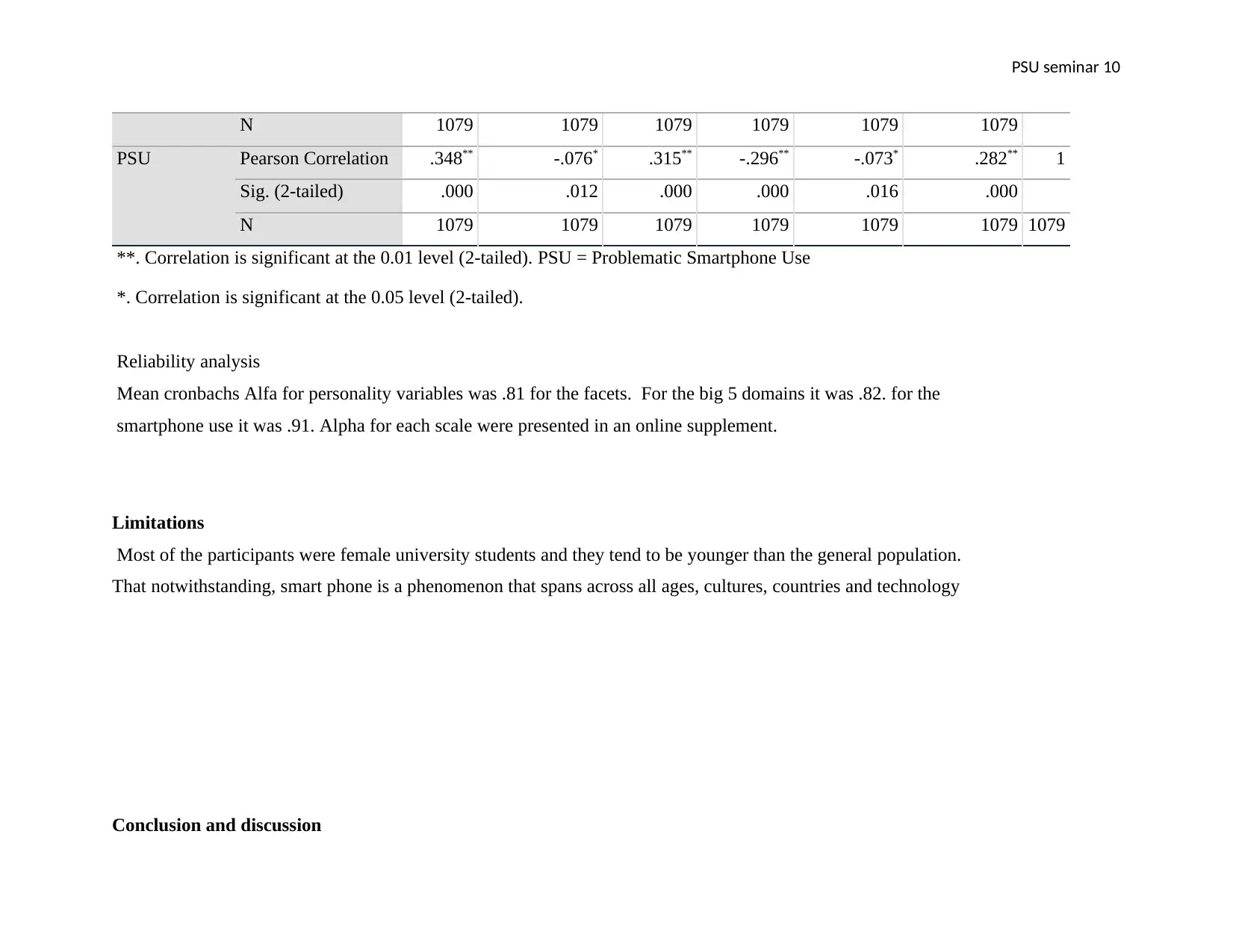
PSU seminar 10
N 1079 1079 1079 1079 1079 1079
PSU Pearson Correlation .348** -.076* .315** -.296** -.073* .282** 1
Sig. (2-tailed) .000 .012 .000 .000 .016 .000
N 1079 1079 1079 1079 1079 1079 1079
**. Correlation is significant at the 0.01 level (2-tailed). PSU = Problematic Smartphone Use
*. Correlation is significant at the 0.05 level (2-tailed).
Reliability analysis
Mean cronbachs Alfa for personality variables was .81 for the facets. For the big 5 domains it was .82. for the
smartphone use it was .91. Alpha for each scale were presented in an online supplement.
Limitations
Most of the participants were female university students and they tend to be younger than the general population.
That notwithstanding, smart phone is a phenomenon that spans across all ages, cultures, countries and technology
Conclusion and discussion
N 1079 1079 1079 1079 1079 1079
PSU Pearson Correlation .348** -.076* .315** -.296** -.073* .282** 1
Sig. (2-tailed) .000 .012 .000 .000 .016 .000
N 1079 1079 1079 1079 1079 1079 1079
**. Correlation is significant at the 0.01 level (2-tailed). PSU = Problematic Smartphone Use
*. Correlation is significant at the 0.05 level (2-tailed).
Reliability analysis
Mean cronbachs Alfa for personality variables was .81 for the facets. For the big 5 domains it was .82. for the
smartphone use it was .91. Alpha for each scale were presented in an online supplement.
Limitations
Most of the participants were female university students and they tend to be younger than the general population.
That notwithstanding, smart phone is a phenomenon that spans across all ages, cultures, countries and technology
Conclusion and discussion
Secure Best Marks with AI Grader
Need help grading? Try our AI Grader for instant feedback on your assignments.
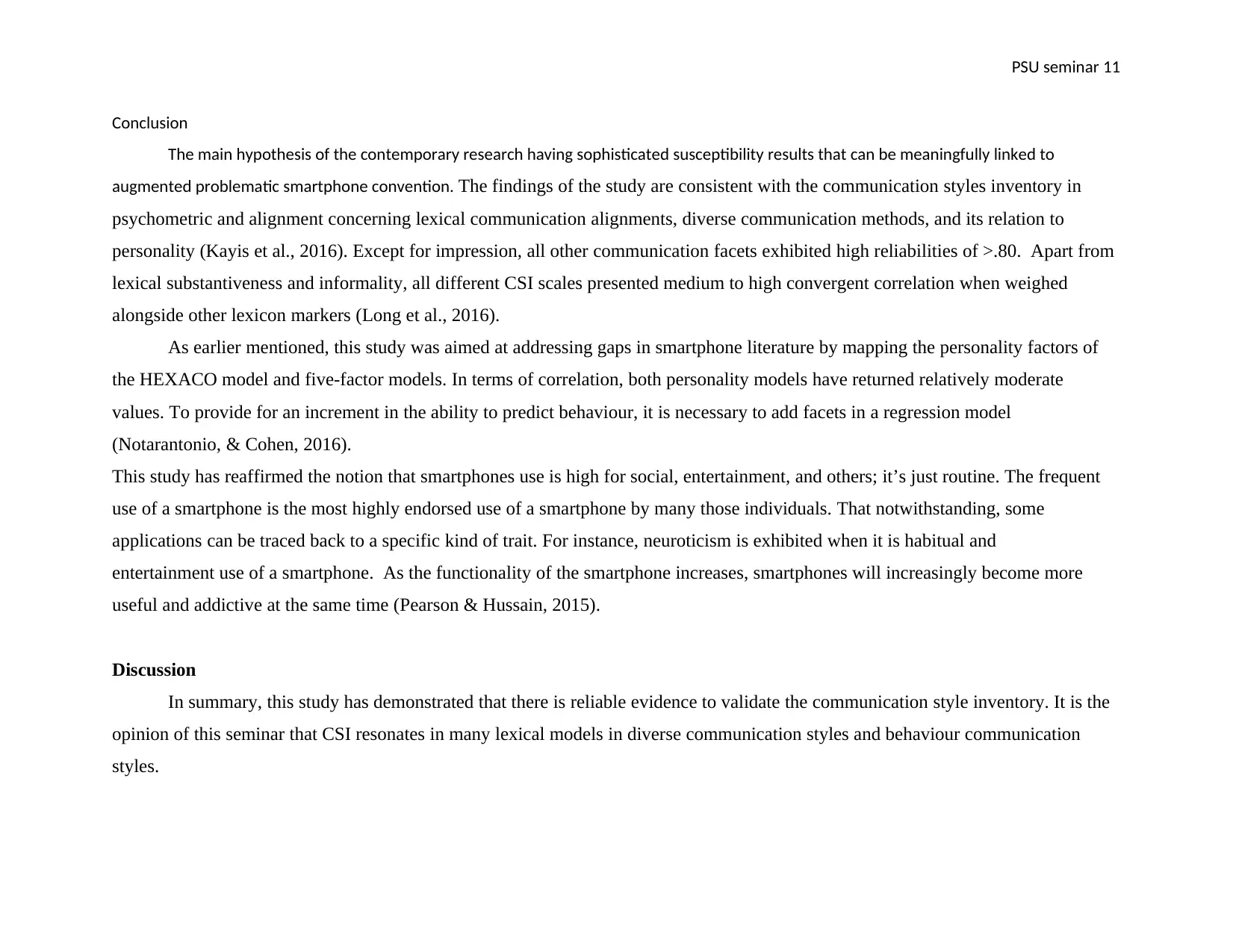
PSU seminar 11
Conclusion
The main hypothesis of the contemporary research having sophisticated susceptibility results that can be meaningfully linked to
augmented problematic smartphone convention. The findings of the study are consistent with the communication styles inventory in
psychometric and alignment concerning lexical communication alignments, diverse communication methods, and its relation to
personality (Kayis et al., 2016). Except for impression, all other communication facets exhibited high reliabilities of >.80. Apart from
lexical substantiveness and informality, all different CSI scales presented medium to high convergent correlation when weighed
alongside other lexicon markers (Long et al., 2016).
As earlier mentioned, this study was aimed at addressing gaps in smartphone literature by mapping the personality factors of
the HEXACO model and five-factor models. In terms of correlation, both personality models have returned relatively moderate
values. To provide for an increment in the ability to predict behaviour, it is necessary to add facets in a regression model
(Notarantonio, & Cohen, 2016).
This study has reaffirmed the notion that smartphones use is high for social, entertainment, and others; it’s just routine. The frequent
use of a smartphone is the most highly endorsed use of a smartphone by many those individuals. That notwithstanding, some
applications can be traced back to a specific kind of trait. For instance, neuroticism is exhibited when it is habitual and
entertainment use of a smartphone. As the functionality of the smartphone increases, smartphones will increasingly become more
useful and addictive at the same time (Pearson & Hussain, 2015).
Discussion
In summary, this study has demonstrated that there is reliable evidence to validate the communication style inventory. It is the
opinion of this seminar that CSI resonates in many lexical models in diverse communication styles and behaviour communication
styles.
Conclusion
The main hypothesis of the contemporary research having sophisticated susceptibility results that can be meaningfully linked to
augmented problematic smartphone convention. The findings of the study are consistent with the communication styles inventory in
psychometric and alignment concerning lexical communication alignments, diverse communication methods, and its relation to
personality (Kayis et al., 2016). Except for impression, all other communication facets exhibited high reliabilities of >.80. Apart from
lexical substantiveness and informality, all different CSI scales presented medium to high convergent correlation when weighed
alongside other lexicon markers (Long et al., 2016).
As earlier mentioned, this study was aimed at addressing gaps in smartphone literature by mapping the personality factors of
the HEXACO model and five-factor models. In terms of correlation, both personality models have returned relatively moderate
values. To provide for an increment in the ability to predict behaviour, it is necessary to add facets in a regression model
(Notarantonio, & Cohen, 2016).
This study has reaffirmed the notion that smartphones use is high for social, entertainment, and others; it’s just routine. The frequent
use of a smartphone is the most highly endorsed use of a smartphone by many those individuals. That notwithstanding, some
applications can be traced back to a specific kind of trait. For instance, neuroticism is exhibited when it is habitual and
entertainment use of a smartphone. As the functionality of the smartphone increases, smartphones will increasingly become more
useful and addictive at the same time (Pearson & Hussain, 2015).
Discussion
In summary, this study has demonstrated that there is reliable evidence to validate the communication style inventory. It is the
opinion of this seminar that CSI resonates in many lexical models in diverse communication styles and behaviour communication
styles.
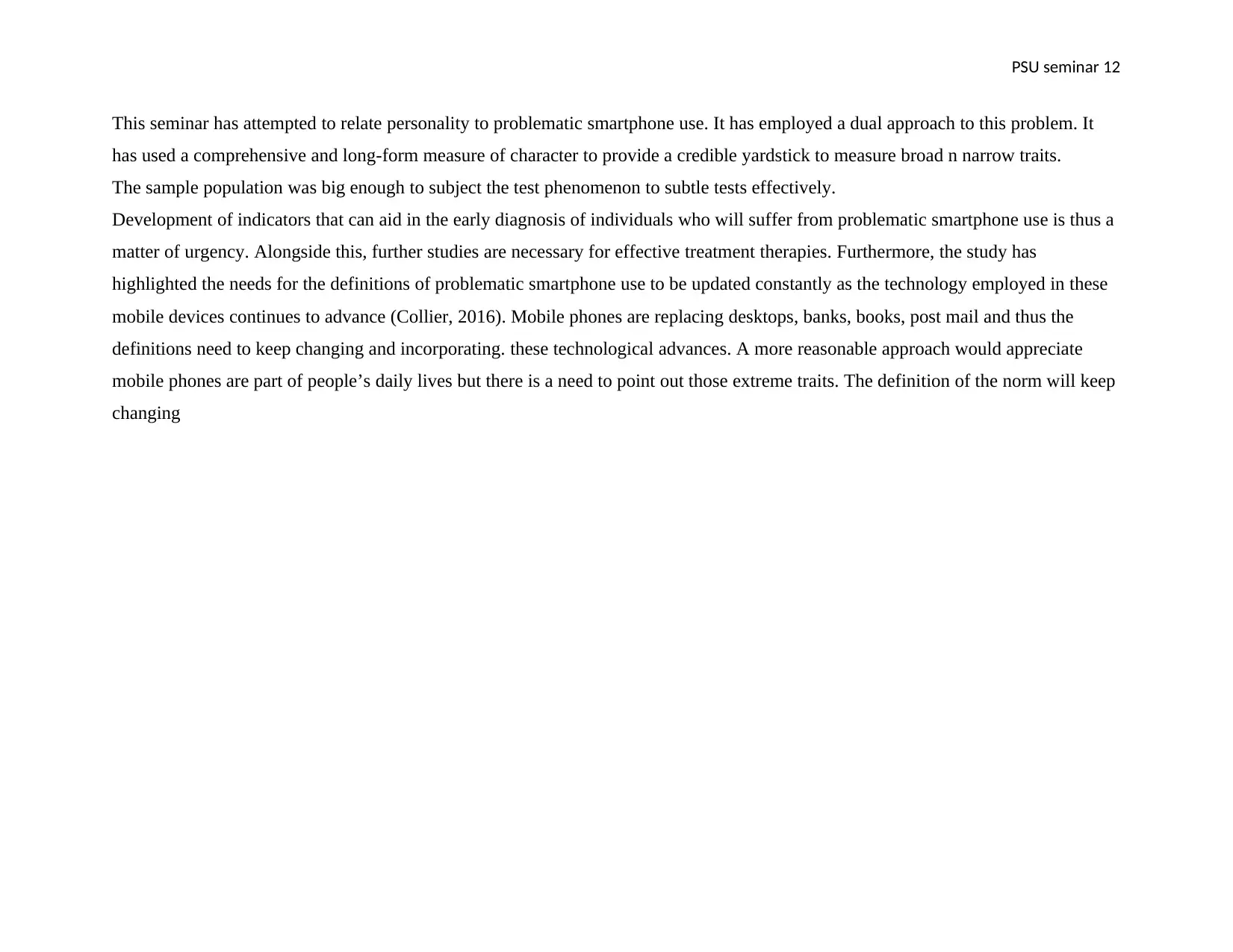
PSU seminar 12
This seminar has attempted to relate personality to problematic smartphone use. It has employed a dual approach to this problem. It
has used a comprehensive and long-form measure of character to provide a credible yardstick to measure broad n narrow traits.
The sample population was big enough to subject the test phenomenon to subtle tests effectively.
Development of indicators that can aid in the early diagnosis of individuals who will suffer from problematic smartphone use is thus a
matter of urgency. Alongside this, further studies are necessary for effective treatment therapies. Furthermore, the study has
highlighted the needs for the definitions of problematic smartphone use to be updated constantly as the technology employed in these
mobile devices continues to advance (Collier, 2016). Mobile phones are replacing desktops, banks, books, post mail and thus the
definitions need to keep changing and incorporating. these technological advances. A more reasonable approach would appreciate
mobile phones are part of people’s daily lives but there is a need to point out those extreme traits. The definition of the norm will keep
changing
This seminar has attempted to relate personality to problematic smartphone use. It has employed a dual approach to this problem. It
has used a comprehensive and long-form measure of character to provide a credible yardstick to measure broad n narrow traits.
The sample population was big enough to subject the test phenomenon to subtle tests effectively.
Development of indicators that can aid in the early diagnosis of individuals who will suffer from problematic smartphone use is thus a
matter of urgency. Alongside this, further studies are necessary for effective treatment therapies. Furthermore, the study has
highlighted the needs for the definitions of problematic smartphone use to be updated constantly as the technology employed in these
mobile devices continues to advance (Collier, 2016). Mobile phones are replacing desktops, banks, books, post mail and thus the
definitions need to keep changing and incorporating. these technological advances. A more reasonable approach would appreciate
mobile phones are part of people’s daily lives but there is a need to point out those extreme traits. The definition of the norm will keep
changing
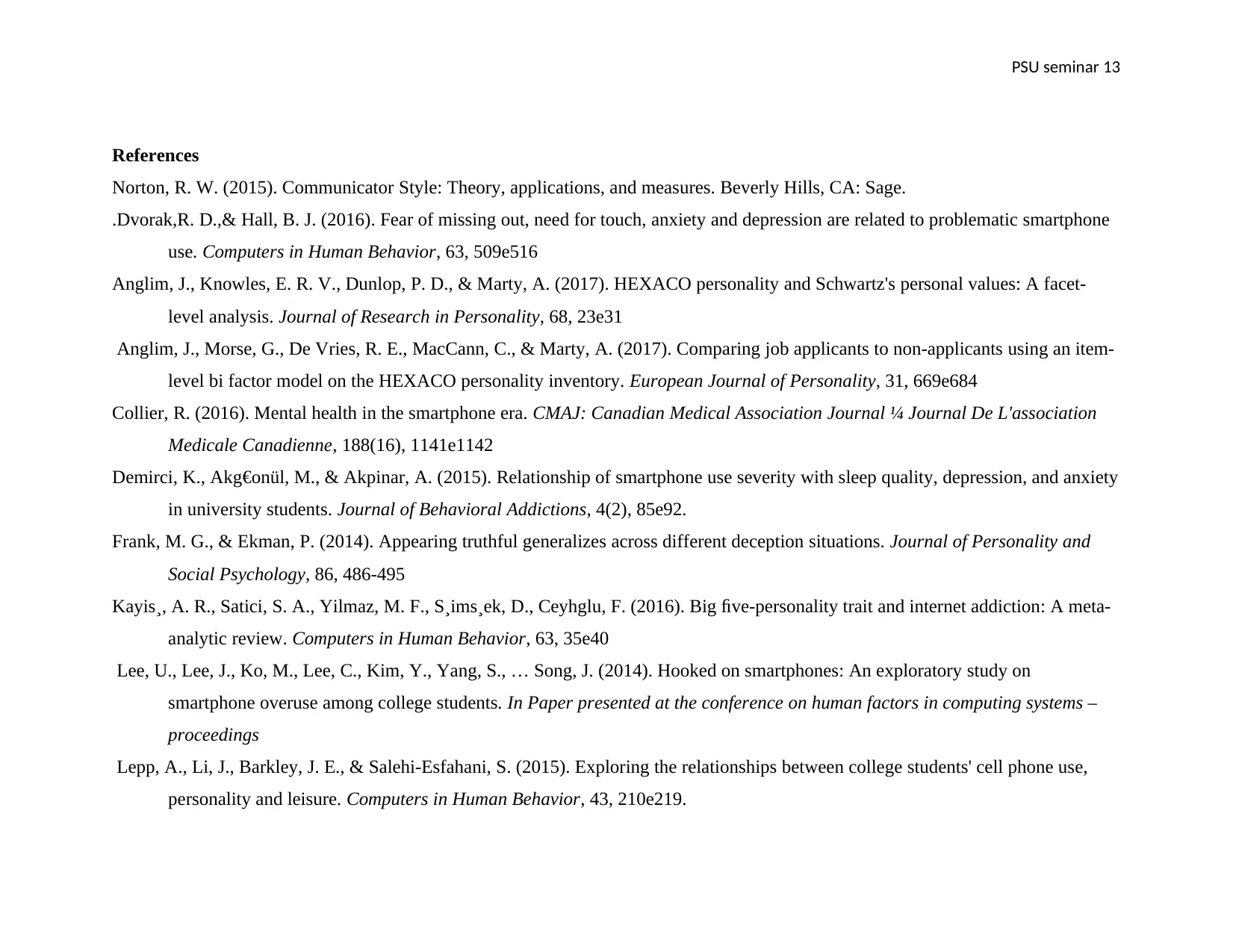
PSU seminar 13
References
Norton, R. W. (2015). Communicator Style: Theory, applications, and measures. Beverly Hills, CA: Sage.
.Dvorak,R. D.,& Hall, B. J. (2016). Fear of missing out, need for touch, anxiety and depression are related to problematic smartphone
use. Computers in Human Behavior, 63, 509e516
Anglim, J., Knowles, E. R. V., Dunlop, P. D., & Marty, A. (2017). HEXACO personality and Schwartz's personal values: A facet-
level analysis. Journal of Research in Personality, 68, 23e31
Anglim, J., Morse, G., De Vries, R. E., MacCann, C., & Marty, A. (2017). Comparing job applicants to non-applicants using an item-
level bi factor model on the HEXACO personality inventory. European Journal of Personality, 31, 669e684
Collier, R. (2016). Mental health in the smartphone era. CMAJ: Canadian Medical Association Journal ¼ Journal De L'association
Medicale Canadienne, 188(16), 1141e1142
Demirci, K., Akg€onül, M., & Akpinar, A. (2015). Relationship of smartphone use severity with sleep quality, depression, and anxiety
in university students. Journal of Behavioral Addictions, 4(2), 85e92.
Frank, M. G., & Ekman, P. (2014). Appearing truthful generalizes across different deception situations. Journal of Personality and
Social Psychology, 86, 486-495
Kayis¸, A. R., Satici, S. A., Yilmaz, M. F., S¸ims¸ek, D., Ceyhglu, F. (2016). Big five-personality trait and internet addiction: A meta-
analytic review. Computers in Human Behavior, 63, 35e40
Lee, U., Lee, J., Ko, M., Lee, C., Kim, Y., Yang, S., … Song, J. (2014). Hooked on smartphones: An exploratory study on
smartphone overuse among college students. In Paper presented at the conference on human factors in computing systems –
proceedings
Lepp, A., Li, J., Barkley, J. E., & Salehi-Esfahani, S. (2015). Exploring the relationships between college students' cell phone use,
personality and leisure. Computers in Human Behavior, 43, 210e219.
References
Norton, R. W. (2015). Communicator Style: Theory, applications, and measures. Beverly Hills, CA: Sage.
.Dvorak,R. D.,& Hall, B. J. (2016). Fear of missing out, need for touch, anxiety and depression are related to problematic smartphone
use. Computers in Human Behavior, 63, 509e516
Anglim, J., Knowles, E. R. V., Dunlop, P. D., & Marty, A. (2017). HEXACO personality and Schwartz's personal values: A facet-
level analysis. Journal of Research in Personality, 68, 23e31
Anglim, J., Morse, G., De Vries, R. E., MacCann, C., & Marty, A. (2017). Comparing job applicants to non-applicants using an item-
level bi factor model on the HEXACO personality inventory. European Journal of Personality, 31, 669e684
Collier, R. (2016). Mental health in the smartphone era. CMAJ: Canadian Medical Association Journal ¼ Journal De L'association
Medicale Canadienne, 188(16), 1141e1142
Demirci, K., Akg€onül, M., & Akpinar, A. (2015). Relationship of smartphone use severity with sleep quality, depression, and anxiety
in university students. Journal of Behavioral Addictions, 4(2), 85e92.
Frank, M. G., & Ekman, P. (2014). Appearing truthful generalizes across different deception situations. Journal of Personality and
Social Psychology, 86, 486-495
Kayis¸, A. R., Satici, S. A., Yilmaz, M. F., S¸ims¸ek, D., Ceyhglu, F. (2016). Big five-personality trait and internet addiction: A meta-
analytic review. Computers in Human Behavior, 63, 35e40
Lee, U., Lee, J., Ko, M., Lee, C., Kim, Y., Yang, S., … Song, J. (2014). Hooked on smartphones: An exploratory study on
smartphone overuse among college students. In Paper presented at the conference on human factors in computing systems –
proceedings
Lepp, A., Li, J., Barkley, J. E., & Salehi-Esfahani, S. (2015). Exploring the relationships between college students' cell phone use,
personality and leisure. Computers in Human Behavior, 43, 210e219.
Paraphrase This Document
Need a fresh take? Get an instant paraphrase of this document with our AI Paraphraser
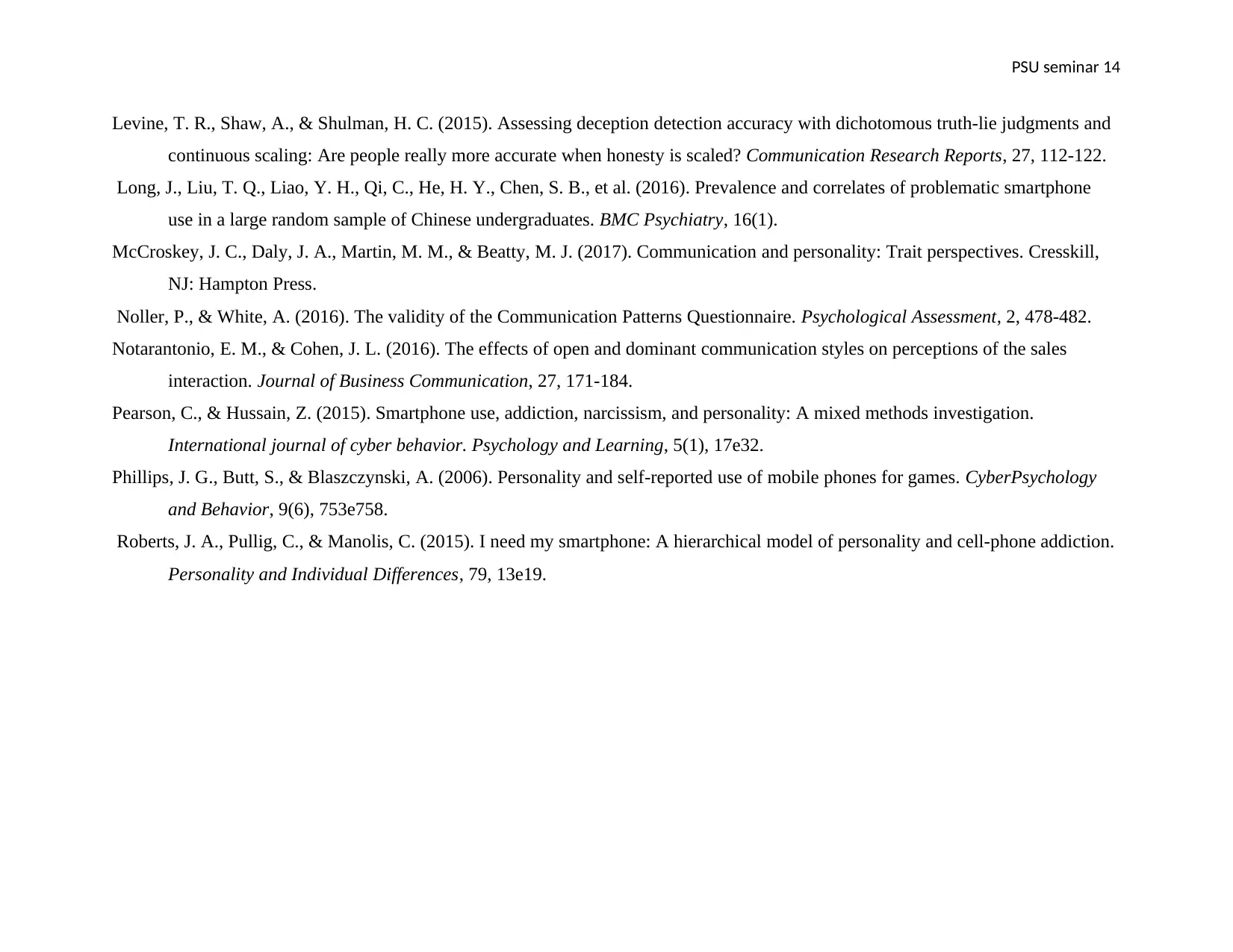
PSU seminar 14
Levine, T. R., Shaw, A., & Shulman, H. C. (2015). Assessing deception detection accuracy with dichotomous truth-lie judgments and
continuous scaling: Are people really more accurate when honesty is scaled? Communication Research Reports, 27, 112-122.
Long, J., Liu, T. Q., Liao, Y. H., Qi, C., He, H. Y., Chen, S. B., et al. (2016). Prevalence and correlates of problematic smartphone
use in a large random sample of Chinese undergraduates. BMC Psychiatry, 16(1).
McCroskey, J. C., Daly, J. A., Martin, M. M., & Beatty, M. J. (2017). Communication and personality: Trait perspectives. Cresskill,
NJ: Hampton Press.
Noller, P., & White, A. (2016). The validity of the Communication Patterns Questionnaire. Psychological Assessment, 2, 478-482.
Notarantonio, E. M., & Cohen, J. L. (2016). The effects of open and dominant communication styles on perceptions of the sales
interaction. Journal of Business Communication, 27, 171-184.
Pearson, C., & Hussain, Z. (2015). Smartphone use, addiction, narcissism, and personality: A mixed methods investigation.
International journal of cyber behavior. Psychology and Learning, 5(1), 17e32.
Phillips, J. G., Butt, S., & Blaszczynski, A. (2006). Personality and self-reported use of mobile phones for games. CyberPsychology
and Behavior, 9(6), 753e758.
Roberts, J. A., Pullig, C., & Manolis, C. (2015). I need my smartphone: A hierarchical model of personality and cell-phone addiction.
Personality and Individual Differences, 79, 13e19.
Levine, T. R., Shaw, A., & Shulman, H. C. (2015). Assessing deception detection accuracy with dichotomous truth-lie judgments and
continuous scaling: Are people really more accurate when honesty is scaled? Communication Research Reports, 27, 112-122.
Long, J., Liu, T. Q., Liao, Y. H., Qi, C., He, H. Y., Chen, S. B., et al. (2016). Prevalence and correlates of problematic smartphone
use in a large random sample of Chinese undergraduates. BMC Psychiatry, 16(1).
McCroskey, J. C., Daly, J. A., Martin, M. M., & Beatty, M. J. (2017). Communication and personality: Trait perspectives. Cresskill,
NJ: Hampton Press.
Noller, P., & White, A. (2016). The validity of the Communication Patterns Questionnaire. Psychological Assessment, 2, 478-482.
Notarantonio, E. M., & Cohen, J. L. (2016). The effects of open and dominant communication styles on perceptions of the sales
interaction. Journal of Business Communication, 27, 171-184.
Pearson, C., & Hussain, Z. (2015). Smartphone use, addiction, narcissism, and personality: A mixed methods investigation.
International journal of cyber behavior. Psychology and Learning, 5(1), 17e32.
Phillips, J. G., Butt, S., & Blaszczynski, A. (2006). Personality and self-reported use of mobile phones for games. CyberPsychology
and Behavior, 9(6), 753e758.
Roberts, J. A., Pullig, C., & Manolis, C. (2015). I need my smartphone: A hierarchical model of personality and cell-phone addiction.
Personality and Individual Differences, 79, 13e19.
1 out of 14
Your All-in-One AI-Powered Toolkit for Academic Success.
+13062052269
info@desklib.com
Available 24*7 on WhatsApp / Email
![[object Object]](/_next/static/media/star-bottom.7253800d.svg)
Unlock your academic potential
© 2024 | Zucol Services PVT LTD | All rights reserved.


